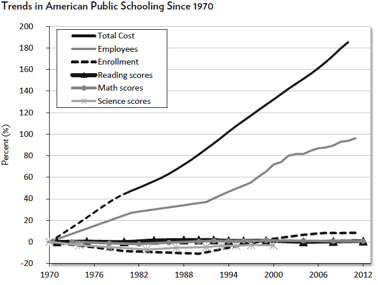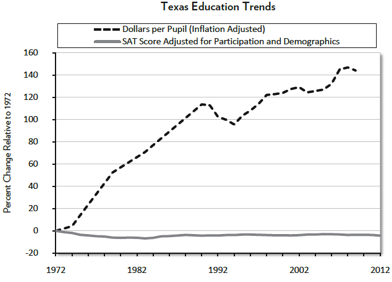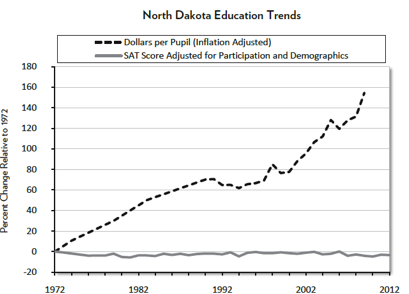Increasing Education Spending Does Not Equal Higher Test Scores
Over the last four decades, education spending has steadily increased in the United States, yet schools are not delivering the return on investment students and families deserve. The total cost to educate a student from kindergarten through high school graduation has nearly tripled from $56,903 in 1972 to $164,426 in 2010 (adjusted for inflation), while National Assessment of Educational Progress (NAEP) scores remained about the same (Figure 1).
Given this snapshot of national spending and scores, how have individual states fared in this time period?

A recent Cato Institute study, focusing specifically on the relationship between state-level spending and test scores, showed a similar trend. The study uses SAT data from 1972 to 2012, adjusted to “offer a plausible estimate of overall state performance on the SAT.” The adjusted SAT scores are compared to K-12 spending over the same period, revealing: “[t]here is essentially no link between state education spending and the performance of students at the end of high school.” While spending in each state grew significantly, SAT scores remained nearly the same.
Looking at particular spending increases, states with the largest populations, California, Texas (Figure 2), and New York, have increased their spending 80, 140, and 120 percent, respectively, while states with lower populations are even worse. Wyoming has increased spending nearly 225 percent, Vermont 175 percent, and North Dakota (Figure 3) 160 percent. Overall, average state spending increased by 120 percent, while the average state saw SAT scores decline by three percent.


States cannot continue floundering in the unsustainable status quo of rising costs and stagnant test scores. Instead, states should embrace common-sense education reforms, such as school choice, that promote efficient spending and drive student learning. School choice, aside from empowering parents to determine the best educational environment for their child, tends to have a positive impact on student learning and saves taxpayer money, according to empirical evidence cited in a recent Friedman Foundation report. Parents should not tolerate wasteful spending, but demand a better return on investment and a brighter future for their children.
